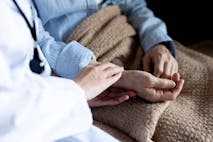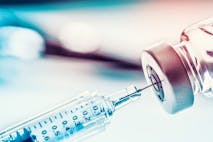
Writer says abortionists are good at IUD insertion because they 'prioritize comfort'
Nancy Flanders
·
Silent Agony: The Lie of 'Death with Dignity'
(NRL News Today) Nearly 1,800 people have jumped from San Francisco’s Golden Gate Bridge, and all but a handful died. The few who survived have all told the same story, like Kevin Hines, who jumped in 2000. He said that the second he let go, he realized that he wanted to live. All of the other survivors echoed him: the moment their hands left the rail, they realized that they wanted to live.
That flash of clarity shows how fast the will to die can collapse and how brutally strong the will to live can fight back. The split-second reversal of desire shows how fleeting suicidal resolve can be, and how the will to survive rises even in the very moment of action.
That truth matters when lawmakers and doctors frame assisted suicide as a settled, rational choice. Once the fatal act begins, regret has no remedy. The Golden Gate Bridge survivors remind us that suicidal feelings are not fixed; they often collapse the moment they are acted upon.

Euthanasia and assisted suicide remove that possibility of reversal. Patients who swallow lethal drugs or receive euthanasia injections are denied the chance to change their minds, even if they immediately feel the same regret the bridge jumpers describe.
The promise of assisted suicide is simple: a drink, a deep sleep, and a quiet end, but the reality is far different. Oregon’s most recent report records patients who lingered for up to 26 hours, with historical cases lasting as long as 137 agonizing hours before they succumbed to the poison. Nine people regained consciousness after ingesting the prescribed cocktail.
In the Netherlands, one out of five assisted suicide cases required doctors to intervene with injections because the oral drugs failed.
Canadian physicians admit they use lidocaine before propofol because the drug burns veins on entry. And even though families rarely hear these details, the data tell the truth: the process is unpredictable and often painful.
Physicians know complications are common, which is why they prescribe powerful anti-nausea drugs to mask vomiting and retching. Yet complications persist. Patients have experienced choking, seizures, or prolonged gasping. In the Netherlands, nearly 7 percent of oral cases included vomiting or failure to induce coma, and almost one in five had to be converted to euthanasia by injection.
UK Parliament approves ‘assisted dying’ bill despite evidence of coercion in other nations
In those moments, regret may flare just as it did for Kevin Hines, but unlike a bridge jumper, these patients cannot pull themselves back.
That is because euthanasia protocols often include a paralytic. After sedation, physicians administer a muscle relaxant such as rocuronium that stops breathing. The paralytic masks signs of struggle. A patient may feel burning from propofol or the terrifying sensation of suffocation, but the body cannot show it. Family members witness what looks like stillness, while the patient may endure agony in silence.
The use of paralytics guarantees that no one will ever know what the patient felt in those final moments. It ensures that suffering remains hidden, not that suffering never occurred.
Canada offers a stark warning about where this path leads. In 2016, the government legalized euthanasia for those with terminal illness. Within a few years, eligibility expanded to people with chronic conditions, then to those with disabilities, and soon it will include individuals struggling with mental illness.
Veterans have reported being offered death when they sought help for PTSD. Disabled citizens have told of being pressured to consider Canada’s tragically named “Medical Aid in Dying” when what they needed was housing or support services.
The parallels to the Golden Gate Bridge survivors are chilling: people in crisis often want help to live, not assistance to die. The difference is that bridge survivors had a modicum of control in trying to position their bodies in a way to avoid death once they jumped; medically paralyzed victims of euthanasia do not.
The ethical cost is also heavy. Medicine is meant to heal and to protect, but now clinicians administer poison that burns veins or prescribe pills that leave patients gasping for breath, the profession loses its foundation of trust. Paralytics may keep the body still, but they cannot silence the reality that a patient may be dying in fear or pain. Families expect care, not abandonment.
Patients deserve dignity, but dignity cannot be found in vomiting, seizures, or in days of slow agonizing decline hidden under a chemical shroud of paralysis.
The stories of survivors who regretted jumping the moment they leapt should give us pause. They reveal the depth of human resilience, even in despair. The data from assisted suicide and euthanasia programs reveal something else, that what begins as a promise of mercy often becomes a reality of incredible suffering, often in silence because of the paralytics.
These truths call us to reject the lie that killing is care. Genuine compassion means standing with those who suffer, offering treatment, presence, and hope. True dignity lies not in hiding agony with a paralytic but in never abandoning those who feel they have nothing left to live for.
Editor's Note: This article was originally published at NRL News Today (National Right to Life News) and is reprinted here with permission.
Live Action News is pro-life news and commentary from a pro-life perspective.
Contact editor@liveaction.org for questions, corrections, or if you are seeking permission to reprint any Live Action News content.
Guest Articles: To submit a guest article to Live Action News, email editor@liveaction.org with an attached Word document of 800-1000 words. Please also attach any photos relevant to your submission if applicable. If your submission is accepted for publication, you will be notified within three weeks. Guest articles are not compensated (see our Open License Agreement). Thank you for your interest in Live Action News!

Nancy Flanders
·
Guest Column
Andrea Trudden
·
Guest Column
Megan Petrey
·
Guest Column
Right to Life UK
·
Guest Column
Right to Life UK
·
Guest Column
Stefano Gennarini, J.D.
·